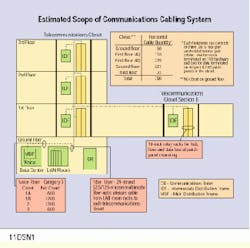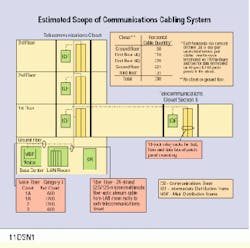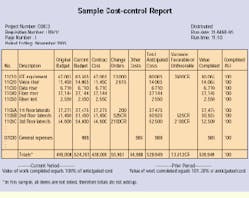As with any cost-estimating endeavor, thoroughness is the key to success.
Matthew Davis,
Tishman Technologies Corp.
Many important decisions can lead a building owner or tenant to justify the installation of a new, universal (standard) cabling system, and it is usually a direct outgrowth of a decision to upgrade a company`s technological capabilities. The first step is to develop a cost estimate for the installation, which involves translating the owner`s needs into a design that fits with the budgeted cost.
During the course of a project, from preconstruction to close-out, whether overseeing the job or acting as contractor or subcontractor, it is important that all parties in the process provide a thorough breakdown of costs. Before discussing the steps involved in costing out a cable plant, however, you need to understand the characteristics of the various types of construction cost estimates--ballpark, budget estimates, complete unit price estimates and the final cost.
The initial rough estimate, which should be used only as a decision-making tool, is the first price quoted when the owner and the estimator begin to discuss the cost of a project and is generally nonbinding. As any installer knows, ballpark estimates can only be given with considerable disclaimer.
The square-foot method is useful for estimating a ballpark figure. The communications construction manager or estimator typically keeps records of the basic cost per square foot for specific types of cabling projects, based on historical data from similar projects or on published square-foot costs, or a little of both. The baseline square-foot costs will also vary for a new building versus retrofit, or re-cabled, installation. To arrive at a square-foot ballpark figure, simply multiply the basic square-foot cost, say $10 per square foot, by the total system area; for example:
$10x100,000 sq. ft. = $1,000,000
A square-foot cost is in no way a final cost, but it is a fairly accurate way to calculate a rough estimate or check a detailed estimate.
Another method for estimating a cabling installation project is to develop a basic per-workstation cost based on data from similar projects. In this estimate, you can incorporate communications backbone costs into the per-workstation cost, or break that out as a separate backbone cost. This is still a ballpark figure, but it can be a useful tool to provide an idea of the project cost.
On the other hand, a budget estimate is generally based on unit prices. Working with the owner or installation designer, the estimator determines cable pathways, quantity of workstations, number of connections for each workstation, and the type and size of backbone required. A rough drawing showing this information is used to prepare the budget estimate, which determines quantities of such cabling system components as horizontal and backbone cabling, termination hardware, and racks and cabinets. In this process, you must make some basic assumptions, including type and jacketing of the cable, typical length of runs and the cost and availability of labor.
Related facilities costs, such as telecommunications closets, sleeves and raceways, must be accounted for at this stage. The result is a budget estimate given to the owner for approval. Typically, the owner will suggest changes to the proposed cabling system if, for example, the cost exceeds the project`s budget or the communications network architecture changes because of operating considerations that require additional cabling or location of termination points.
Upon budget approval, the project is then designed and specified in detail, and competitive bids are solicited.
Detailed budget estimate
The bid process provides hard labor-and-materials costs, and it is now time to prepare a final detailed budget estimate. It is helpful to enter the estimate into a spreadsheet-type format, broken down by labor-and-material components.
The detailed estimate is the basis for a cost-control report that will be updated continually throughout the project by entering the ongoing actual costs for comparison to the original estimate. Using this cost control process, you can verify payment requests, predict cash flow requirements and monitor project costs. This detailed level of reporting also gives your customers the confidence that their cabling investment is being managed wisely.
Securing complete bids
Many owners today look to a communications installation team to provide a complete operational system. Unfortunately, some items that make a job complete may not be specified in the design documents. To render all bids comparable, bidders should be asked to identify such unspecified items as "items not included in bid," and quote them separately from the base bid. For the project owner, the communications construction manager, the designer and the installer, the goal is to provide a complete operational system.
Items which are often left out of the specifications include the following:
-Computer room cabling
-Crossconnections, patch cords, and workstation cords
-Placement and connection of workstation equipment
-Handling and installation of computer room and communications closet equipment
-Firestopping materials
-Testing and as-built documentation
-Insurance, sales tax and other administrative costs
-Move-in support personnel.
The final cost can only be calculated when the project is complete and the client is satisfied with the performance of the system.
Design drives cost
It is also important to understand the cable cost within the context of the company`s overall communications plant. The cost of cabling is a significant part--from 5% to 20%--of the overall communications costs. Both new cabling installations and upgrades can run from $2 to $5 per square foot and, for technologically intensive applications, increase to $50 per square foot.
Communications cabling costs, however, can be justified when the owner understands that the installation is a universal cabling system that can better accommodate moves and changes, compared with older system-specific cabling. Universal cabling generally refers to the installation of one uniform type of wiring and one set number of terminations for every workstation. In a traditional (or non-universal) scenario, new cables must be pulled when a user moves, and one move can cost as much as $2500. With a universal cabling system, the users can essentially plug in anywhere and get to work by moving or adding patch cords.
Another task to define before producing a cabling installation cost estimate is the design, because the cost of a cabling system is ultimately a function of its intended use or application. The design criteria for the cabling system, therefore, should be developed along with several other considerations outlined below:
-Requirements of current and anticipated voice/data applications: telephone, facsimile, paging, dial-up applications (modems), local and wide area network connections, main frame applications, point-of-sale systems, market data services.
-Quantity of users, nature of their business, and the intended users` level of technological sophistication: size of work groups, need for shared information, security concerns, the likelihood of multiple connections and applications for individual users.
-Physical attributes of the facility and their effect on the methods of cable distribution: The costs associated with cabling for a tenant occupying several floors in a high-rise building are markedly different from those associated with cabling a single-story or campus environment. Cables may be routed through plenum ceilings, raised floors or conduit systems, all of which have differing cost factors.
-The type of electronic data transport equipment to be used: Most large users are migrating to LAN-based data communications. Selection of the type of network--for example, Ethernet or token ring--and whether mainframe connections are made point-to-point or through the LAN, will impact the design and cost of the cabling system.
-The volatility of the user: susceptibility to moves, adds, and changes: If a company experiences a churn rate (relocation of personnel because of turnover and reorganization) of 20%, which is common in larger companies, it should consider a universal cabling system to ease operating issues and reduce costs.
-The resources that will be used to operate the communications network after the installation is complete: With operating budgets and staffs routinely cut, an owner may want to centralize the points for monitoring and managing the cabling system as much as possible. A cable management system that accurately tracks the facility`s cabling resources should be incorporated into the cabling system capital cost. Such a system will pay for itself many times over with savings in operating costs.
When pricing a cabling system, thoroughness is key. The following are some dos and don`ts to consider:
-Do not assume that one communications outlet will be sufficient when pricing a system. Common areas, shared equipment and future users must also be considered.
-Do be comprehensive and consider every activity necessary for establishing connectivity.
-Do allow for waste when estimating bulk cable quantities. Unless detailed plans for a large cabling system are available, it is best to assume an average length for horizontal cabling with 15% to 20% of waste included.
-Don`t forget that a site visit is imperative for any cabling estimate because installation conditions can impact the amount of labor and overtime costs required for an installation.
CASE STUDIES
Renovation and relocation building project
Tishman Technologies teamed with Walsh-Lowe & Associates (Hoboken, NJ) as communications cabling design/builder to undertake the installation of a universal cabling system for a major medical instruments manufacturer, which was relocating its headquarters to an existing building. The client leased an approximately 250,000-square-foot three-story building in the suburbs of New York City, and was undertaking the move to consolidate under one roof two separate facilities of 550 employees.
In addition to operations space with open-plan workstations and executive office areas, the building contains 12 conference rooms with video-conferencing capabilities, seven research labs, a new cafeteria and dining area, and an outdoor eating/seating/ garden area.
The costing out of the project proceeded as follows:
-Ballpark: Based on the layout of the building and the relatively technologically intensive nature of the client, we estimated a design/build price of $2.50 per square foot.
- Budget estimate: After further discussions with the customer, the scope of the cabling system was refined. A complete design/build budget estimate that came in at almost $2.85 per square foot was prepared and accepted.
-Cost updates: During the design phase, detailed plans and specifications were prepared in less than one month. Some scope increases, including an additional communications closet to cut down on horizontal cable lengths and extensive special cabling for an electronic research lab, were incorporated into a lump sum bid that was awarded within the budget.
-Final cost: Throughout the course of the project various revisions to the plans increased the number of workstations and added cabling. The client also elected to have all computer room work and move-in support added to the contract, which increased the budget accordingly. The final cabling cost for the project came to about $3.45 per square foot.
The budget cost estimate proved accurate. All increases to the final cost were directly attributable to increases in the scope of the project requested by the owner during the course of the work. Most importantly, the cabling system--for which the design authorization was released six months later than the balance of the project design--was completed on time without impacting any other fit-out work on the project.
Installation in high-rise building
Another major installation--for a securities brokerage firm this time--involved the cabling of 500,000 square feet of space in a new 42-story building. The building accommodated securities-processing operations that were being relocated from New York City to New Jersey. The typical per-square-foot cost for this technically intensive cabling project is $5 to $6 per square foot.
This project differs from the prior case study in that it spanned more than 20 floors in a newly constructed high-rise building. At the time the cabling was planned, performance standards for Category 5 cabling (such as Electronic Industries Association/ Telecommunications Industry Association standard 568), around which systems are now designed, had not been written. The client was also different because the company had just completed other moves of a larger magnitude and had the resources on staff to do all communications design work.
The cabling design for the project included two separate risers and two communications closets on each floor fed from a 20,000-square-foot technology room on one of the lower floors. The horizontal cables, three-cable composite-types in a single jacket, were installed through raised floors in the entire system.
The cost estimate proceeded as follows:
-First, we gave the project owner a ballpark figure of $10 per square foot, based on a review of the conceptual design drawings and previous experience with the client.
-Next, we came up with a budget estimate by reviewing the detailed design and checking the capabilities of the local cabling contractors. This also took into consideration the economies provided by the new type of cable used, which resulted in revising our estimate to approximately $6 per square foot.
-Then we put the project out to bid and six contractors responded. We picked the one best qualified for the project, who was also certified by the manufacturer of the major components of the project and, coincidentally, gave us the best price.
-From there, the costs from the budget estimate were entered onto a spreadsheet and tracked and updated on a weekly basis. The cost for the cabling system came in just under $5 per square foot.
The overall cost changes amounted to less than 3%, all attributable to scope changes associated with developing more space than initially anticipated. The project involved 14 floors with more than 100,000 terminations. As many as 1200 pieces of telecommunications equipment were moved during the weekend for the start of work on Monday.
The Basics of Estimating a Cabling System
The following is a summary of the basic steps to estimate the cost of a cabling system:
-Review communications needs with the company principals and establish rough design criteria for the project. Budgetary ballpark costs based on these criteria should be determined at this point.
-Before a more-detailed budget can be established, some primary aspects of the communications plan must be decided--namely, the type of telephone system that will be used and the type of data transport equipment required. Equipment selection is feature- and application-driven with direct bearing on the cabling system design and cost. With these decisions out of the way, a more accurate budget estimate can be produced quickly.
-Once budgets are established, prepare either a generic or specific design. A generic design is a performance specification that spells out the requirements of a system, number of outlets, and type of media to be used without detailing every cable, termination point, and other installation items. This design must be suitable for procuring a price from a vendor who has the capability to design, document, furnish and install the cabling system. On the other hand, a specific design includes all the details of a system and is suitable for securing competitive bid pricing for providing the system from qualified vendors.
-Depending on the type of design information available, prepare either a labor-and-materials or a unit-price estimate for use as a cost report breakdown and for comparison with, and analysis of, the competitive bids.
Establish the final cost of the project based on the owner`s complete scope of work and the hard labor-and-materials costs for the project.
Illustration of scope of communications cable system, prepared from budget estimate information, shows cable pathways, type of cable and size of backbone.
Matthew Davis is vice president at Tishman Technologies, New York, NY.


